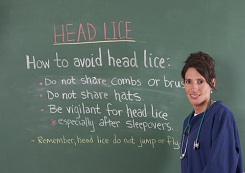 The news of a head lice outbreak at school is one of the most common, albeit most upsetting, aspects of raising children. Some schools seem to have an outbreak every year, and transmission is common among kids who come into close contact with one another through play and socialization. While there’s little you can do to limit kids’ exposure to head lice, there are a few things you can do to reduce their chances of bringing an infestation home.
The news of a head lice outbreak at school is one of the most common, albeit most upsetting, aspects of raising children. Some schools seem to have an outbreak every year, and transmission is common among kids who come into close contact with one another through play and socialization. While there’s little you can do to limit kids’ exposure to head lice, there are a few things you can do to reduce their chances of bringing an infestation home.
- Talk About Appropriate Versus Inappropriate Sharing – After spending your kids’ early years impressing upon them the importance of sharing, the last thing that you probably want to do is start talking about times when they shouldn’t share. This is, however, one of your most effective lines of defense when an outbreak of head lice is ravaging the population of your child’s school. Make a point of talking about appropriate sharing versus inappropriate sharing with your child before messages come home about reported cases of head lice to minimize her chance of bringing these little critters home.
- Check Kids’ Hair Regularly – You should regularly check your kids’ hair for lice, even if there have been no reported outbreaks of lice in their school. It’s especially wise to do so after sleepovers and overnight play dates to reduce the chances of your kids’ bedclothes and the rest of the house becoming invested by any nits or lice they may have picked up at a slumber party.
- Buy Hair Products That Do Double-Duty – There are shampoos, conditioners and detangling products on the market designed to prevent or lessen the likelihood of a head lice infestation, and many are made from all-natural substances. Look for these products when your kids start attending school, and just make the switch a permanent one while they’re still young and unclear about how lice are spread.
- Maintain an Open Line of Communication With Teachers and School Administrators – Your child may have a letter sent home from school detailing a recent reported case of head lice or an ongoing outbreak, but that letter may also never make it to your hands since it probably won’t need to be signed and returned. Making sure that you’re maintaining an open line of communication with your child’s teachers and school administrators can help you get the message about possible infestations when the news breaks, helping you to contain the situation if your child has been exposed and prompting you to check for signs of lice.
- Help Older Kids Understand How Lice Spread – Small children may become terrified at the idea of tiny bugs living on their head, and may not yet be able to grasp just where they come from or how kids spread them to one another. Older kids, however, can understand that head-to-head contact, sharing hats and hair products and other behavior of this kind can help one person transmit head lice to another. Make sure that, when they’re old enough to process the information without panicking, your kids know how head lice spread and what they can do to minimize their exposure whenever possible.
Should all of your efforts prove to be in vain, there is a wider selection of treatment options available now than in years past. All-natural treatments are even gaining ground in many circles, though some products may require more than one application to be truly effective. Be sure that you’re not only treating kids’ heads, but also their beds, clothing and personal items to stamp out an infestation, should one take root.